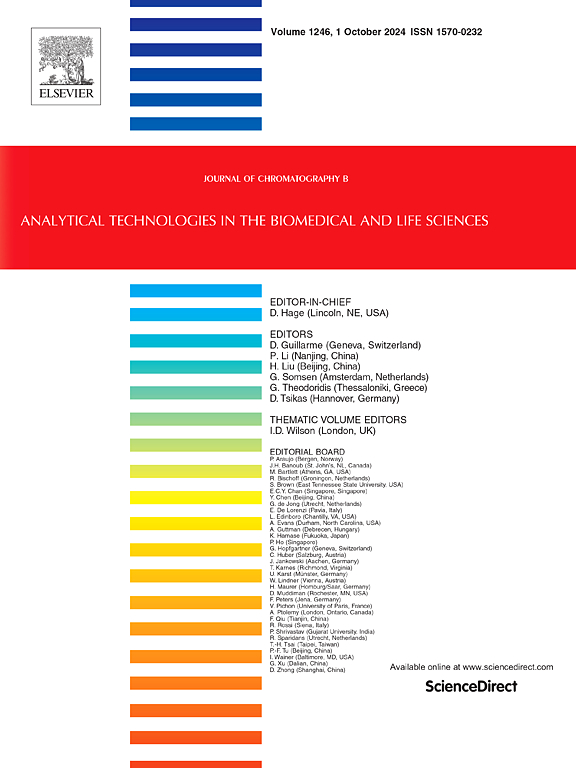Magnetic solid-phase extraction combined with UPLC-MS/MS: A novel application for the analysis of alkylphenols and bisphenols in urine
IF 2.8
3区 医学
Q2 BIOCHEMICAL RESEARCH METHODS
引用次数: 0
Abstract
A rapid, sensitive, simple, and accurate method was developed for the simultaneous determination of 3 alkylphenols (APs) and 11 bisphenols (BPs) in urine based on ultra-performance liquid chromatography-tandem mass spectrometry (UPLC-MS/MS). Following enzymatic hydrolysis of urine samples, corresponding isotope internal standards were added. Magnetic solid-phase extraction (M-SPE) technology was employed for separation and enrichment of analytes, followed by UPLC-MS/MS analysis. Results showed that within the defined concentration ranges, calibration curves for both APs and BPs exhibited excellent linearity, with all correlation coefficients (r) >0.999. The method demonstrated excellent precision and accuracy, with intra- and inter-day coefficients of variation (CVs) < 4.4 % and 4.9 %, respectively, and recoveries ranging from 80.8 % to 107.7 %. Limits of detection (LODs) of the 14 target analytes were 0.006 ng/mL–0.6 ng/mL, and limits of quantification (LOQs) were 0.02 ng/mL–2.0 ng/mL. When applied to quantify APs and BPs in urine samples, the method proved effective, demonstrating rapidity, sensitivity, simplicity, and accuracy, thus making it highly suitable for detecting APs and BPs in urine.
磁固相萃取联合超高效液相色谱-质谱联用:分析尿液中烷基酚和双酚的新方法
建立了一种快速、灵敏、简便、准确的超高效液相色谱-串联质谱(UPLC-MS/MS)同时测定尿液中3种烷基酚(APs)和11种双酚(bp)的方法。将尿样酶解后,加入相应的同位素内标。采用磁固相萃取(M-SPE)技术对分析物进行分离富集,然后进行UPLC-MS/MS分析。结果表明,在规定的浓度范围内,APs和bp的校准曲线均具有良好的线性关系,相关系数(r)均为>;0.999。该方法具有良好的精密度和准确度,日内和日间变异系数(cv) <;加样回收率为80.8% ~ 107.7%。14种目标分析物的检出限为0.006 ng/mL ~ 0.6 ng/mL,定量限为0.02 ng/mL ~ 2.0 ng/mL。结果表明,该方法快速、灵敏、简便、准确,适用于尿液中APs和bp的检测。
本文章由计算机程序翻译,如有差异,请以英文原文为准。
求助全文
约1分钟内获得全文
求助全文
来源期刊

Journal of Chromatography B
医学-分析化学
CiteScore
5.60
自引率
3.30%
发文量
306
审稿时长
44 days
期刊介绍:
The Journal of Chromatography B publishes papers on developments in separation science relevant to biology and biomedical research including both fundamental advances and applications. Analytical techniques which may be considered include the various facets of chromatography, electrophoresis and related methods, affinity and immunoaffinity-based methodologies, hyphenated and other multi-dimensional techniques, and microanalytical approaches. The journal also considers articles reporting developments in sample preparation, detection techniques including mass spectrometry, and data handling and analysis.
Developments related to preparative separations for the isolation and purification of components of biological systems may be published, including chromatographic and electrophoretic methods, affinity separations, field flow fractionation and other preparative approaches.
Applications to the analysis of biological systems and samples will be considered when the analytical science contains a significant element of novelty, e.g. a new approach to the separation of a compound, novel combination of analytical techniques, or significantly improved analytical performance.
 求助内容:
求助内容: 应助结果提醒方式:
应助结果提醒方式:


